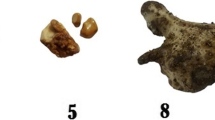Summary
The presence of lipids in urinary stones was determined by histochemical and biochemical methods. When crystals of calcium oxalate, made by mixing calcium chloride and potassium oxalate solutions and sections of human calcium oxalate urinary stones, were exposed to osmium vapors, there was no staining of the pure crystals whereas the stone sections were stained. De-paraffinized sections of demineralized calcium oxalate stones showed positive sudanophilia on staining with Sudan black B. Both these experiments indicate the presence of lipids in calcium oxalate stones. Lipids were extracted from uric acid, struvite, and calcium oxalate stones using standard techniques. Phospholipids were separated by one-dimensional thin layer chromatography. All the stones studied contained lipids. In calcium oxalate stones they accounted for 10.15% of the matrix. Calcium oxalate and struvite stones contained more phospholipids than uric acid stones. Cardiolipin, sphingomyelin, phosphatidyl choline, phosphatidyl inositol, phosphatidyl ethanolamine, phosphatidyl serine, and phosphatidyl glycerol were identified in lipid extracts. Demineralization by ethylenediaminetetraacetate (EDTA) treatment increased lipid output from calcium oxalate stones by 15.5%.
Similar content being viewed by others
References
Irving JT, Wuthier RE (1968) Histochemistry and biochemistry of calcification with special reference to the role of lipids. Clin Orthopaed 56:237–260
Wuthier RE (1968) Lipids of mineralizing epiphyseal tissues in the bone fetus. J Lipid Res 9:68–78
Shapiro IM (1970) The association of phospholipids with anorganic bone. Calcif Tissue Res 5:13–20
Odutuga AA, Prout RES (1974) Lipid analysis of human enamel and dentine. Archs Oral Biol 19:729–731
Ennever J, Vogel JJ, Riggan LJ (1978) Phospholipids of a bone matrix calcification nucleator. J Dental Res 57:731–734
Boskey AL, Boyan-Salyers BD, Burstein LS, Mandel ID (1981) Lipids associated with mineralization of human submandibular gland sialoliths. Arch Oral Biol 26:779–785
Ennever J, Vogel JJ, Benson LA (1973) Lipid and calculus matrix calcification in vitro. J Dent Res 52:1056–1059
Odutuga AA, Prout RES, Hoare RJ (1975) Hydroxyapatite precipitation in vitro by lipids extracted from mammalian hard and soft tissues. Archs Oral Biol 20:311–316
Ennever J, Boyan-Salyers BD, Riggan LJ (1977) Proteolipid and bone matrix calcification. J Dent Res 56:967–970
Ennever J, Vogel JJ, Riggan LJ, Paoloski SB (1977) Proteolipid and calculus matrix calcification in vitro. J Dent Res 56:140–142
Boskey AL, Posner AS (1977) The role of synthetic and bone-extracted Ca-phospholipid-PO4 complexes in hydroxyapatite formation. Calcif Tissue Res 23:251–258
Boyce WH (1972) Some observations on the ultrastructure of “idiopathic” human renal calculi. In: Finlayson B, Hench LL, Smith LH (ed) Urolithiasis: physical aspects. National Academy of Sciences, Washington, DC, p 97
Kim KM, Johnson FB (1981) Calcium oxalate crystal growth in human urinary stones. Scan Elect Microsc III:146–154
Khan SR, Finlayson B, Hackett RL (1983) Agar-embedded urinary stones: a technique useful for studying microscopic architecture. J Urol 83:992–995
Folch J, Lees M, Sloan Stanley GH (1957) A simple method for the isolation and purification of total lipids from animal tissues. J Biol Chem 226:497–509
Rouser G, Siakotos AN, Fleischer S (1966) Quantitative analysis of phospholipids by thin layer chromatography and phosphorus analysis of spots. Lipids 1:85–86
Kates M (1986) Techniques of lipidology: isolation, analysis and identification of lipids. North-Holland/American Elsevier. Amsterdam, New York, 502
Shapiro IM (1970) The phospholipids of mineralized tissues. I. Mammalian compact bone. Calcif Tissue Res 5, 21–29
Boskey AL (1981) Current concepts of the physiology and biochemistry of calcification. Clin Orthopaed 157:225–257
Slomiany BL, Murty VLN, Aono M, Slomiany A, Mandel ID (1982) Lipid composition of the matrix of human submandibular salivary gland stones. Archs Oral Biol 27:673–677
Slomiany BL, Murty VLN, Aono M, Sarosiek J, Slomiany A, Mandel ID (1983) Lipids of supragingival calculus. J Dent Res 62:862–865
Vogel JJ, Boyan-Salyers BD (1976) Acidic lipids associated with the local mechanism of calcification. Clin Orthopaed 118:230–240
Jackson RL, Gotto AM (1974) Phospholipids in biology and medicine. N Engl J Med 290:87–93
Finlayson B, Khan SR, Hackett RL (1984) Mechanisms of stone formation—an overview. Scann Elect Microsc III:1419–1425
Anderson HC (1980) Calcification processes. Pathol Annu 15:45–75
Anderson HC (1983) Calcific diseases. Arch Pathol Lab Med 107:341–348
Valente M, Bortolotti U, Theine G (1985) Ultrastructural substrates of dystrophic calcification in porcine bioprosthetic valve failure. Am J Pathol 119:12–21
Schoen FJ, Tsao JW, Levy RJ (1986) Calcification of bovine pericardium used in cardiac valve bioprostheses: implications for the mechanisms of bioprosthetic tissue mineralization. Am J Pathol 123:134–145
Boyan-Salyers BD, Boskey AL (1980) Relationship between proteolipids and calcium-phospholipid-phosphate complexes inBacterionema matruchotii calcification. Calcif Tissue Int 30:167–174
Meyer JL, Bergert JH, Smith LH (1975) Epitaxial relationships in urolithiasis: the calcium oxalate monohydrate-hydroxyapatite system. Clin Sci Mol Med 49:369–374
Werness PG, Wilson JWL, Smith LH (1984) Hydroxyapatite and its role in calcium urolithiasis. In: Yall R, Brockis JG, Marshall V, Finlayson B (ed) Urinary stones. Churchill Livingstone, New York, p 273
Author information
Authors and Affiliations
Rights and permissions
About this article
Cite this article
Khan, S.R., Shevock, P.N. & Hackett, R.L. Presence of lipids in urinary stones: Results of preliminary studies. Calcif Tissue Int 42, 91–96 (1988). https://doi.org/10.1007/BF02556340
Received:
Revised:
Issue Date:
DOI: https://doi.org/10.1007/BF02556340




